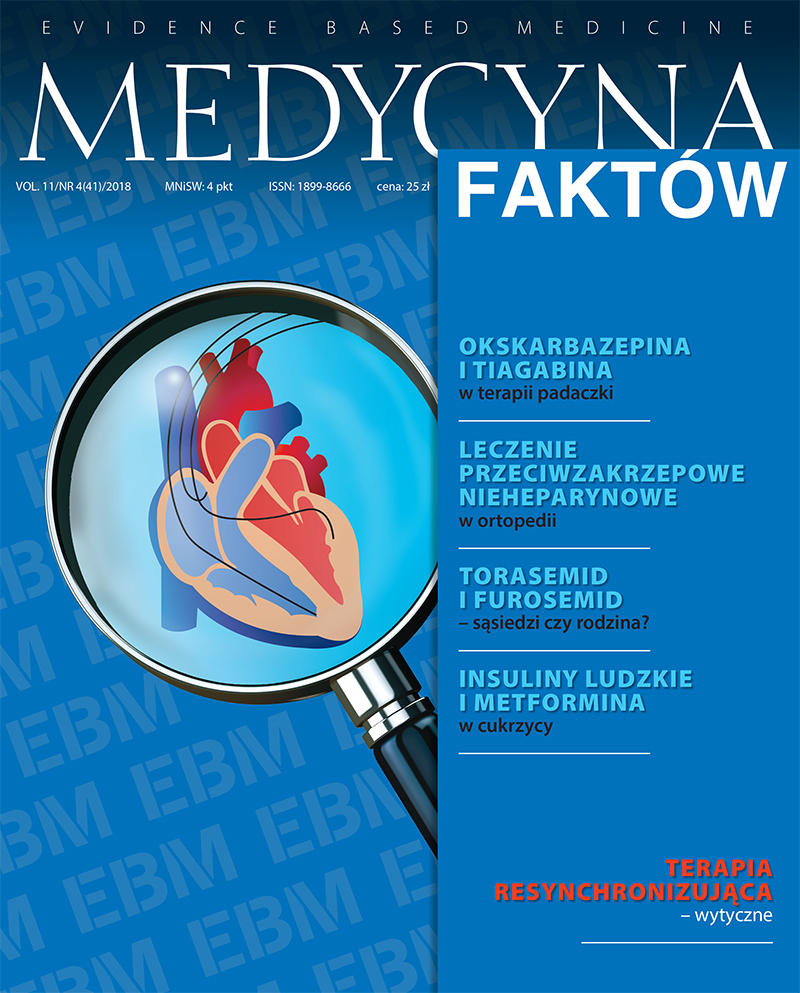Why do I use ivabradine in my patients? Review article
Main Article Content
Abstract
Ivabradine inhibits sinus node IF channels and lowers the heart rate. It is used in patients with sinus rhytm and heart rate of ≥70/min, who despite the optimal treatment failed to achieve the correct one. In the trials, ivabradine significantly reduced the mortality due to heart failure (26%, p = 0.014) and the risk of hospitalization due to exacerbation of heart failure (18%). Due to neutral influence on hemodynamic parameters and inotropic effects, ivabradine can be administered in patients with elevated heart rate who do not achieve the target dose of β-blockers. Despite the undoubted benefits and clear ESC recommendations, ivabradine is still used in too few patients with HFrEF.
Article Details
How to Cite
Straburzyńska-Migaj , E., & Nowak, A. (2018). Why do I use ivabradine in my patients?. Medycyna Faktow (J EBM), 11(4(41), 301-304. https://doi.org/10.24292/01.MF.0418.7
Issue
Section
Articles
Copyright © by Medical Education. All rights reserved.
References
1. McMurray J.J.V., Adamopoulos S., Anker S.D. et al.: Wytyczne ESC dotyczące rozpoznania oraz leczenia ostrej i przewlekłej niewydolności serca na 2012 rok. Kardiol. Pol. 2012; 70(supl. II): 101-176.
2. Ponikowski P., Voors A.A., Anker S.D. et al.: Wytyczne ESC dotyczące diagnostyki i leczenia ostrej i przewlekłej niewydolności serca w 2016 roku. Kardiol. Pol. 2016; 74(10): 1037-1147.
3. Montalescot G., Sechtern U., Achenbach S. et al.: Wytyczne ESC dotyczące postępowania w stabilnej chorobie wieńcowej w 2013 roku. Kardiol. Pol. 2013; 71(supl. X): 243-318.
4. Swedberg K., Komajda M., Böhm M. et al.: Ivabradine and outcomes in chronic heart failure (SHIFT): a randomised placebo-controlled study. Lancet 2010; 376: 875-885.
5. Bagriy A.E., Schukina E.V., Samoilova O.V. et al.: Addition of ivabradine to β-blocker improves exercise capacity in systolic heart failure patients in a prospective, open-label study. Adv. Ther. 2015; 32(2): 108-119.
6. Hidalgo F.J., Anguita M., Castillo J.C. et al.: Effect of early treatment with ivabradine combined with beta-blockers versus beta-blockers alone in patients hospitalised with heart failure and reduced left ventricular ejection fraction (ETHIC-AHF): A randomised study. Int. J. Cardiol. 2016; 217: 7-11.
7. Opolski G., Ozierański K., Lelonek M. et al. On Behalf Of The Polish Qualify Investigators: Adherence to the guidelines on the management of systolic heart failure in ambulatory care in Poland. Data from the international QUALIFY survey. Pol. Arch. Intern. Med. 2017;127(10): 657-665.
2. Ponikowski P., Voors A.A., Anker S.D. et al.: Wytyczne ESC dotyczące diagnostyki i leczenia ostrej i przewlekłej niewydolności serca w 2016 roku. Kardiol. Pol. 2016; 74(10): 1037-1147.
3. Montalescot G., Sechtern U., Achenbach S. et al.: Wytyczne ESC dotyczące postępowania w stabilnej chorobie wieńcowej w 2013 roku. Kardiol. Pol. 2013; 71(supl. X): 243-318.
4. Swedberg K., Komajda M., Böhm M. et al.: Ivabradine and outcomes in chronic heart failure (SHIFT): a randomised placebo-controlled study. Lancet 2010; 376: 875-885.
5. Bagriy A.E., Schukina E.V., Samoilova O.V. et al.: Addition of ivabradine to β-blocker improves exercise capacity in systolic heart failure patients in a prospective, open-label study. Adv. Ther. 2015; 32(2): 108-119.
6. Hidalgo F.J., Anguita M., Castillo J.C. et al.: Effect of early treatment with ivabradine combined with beta-blockers versus beta-blockers alone in patients hospitalised with heart failure and reduced left ventricular ejection fraction (ETHIC-AHF): A randomised study. Int. J. Cardiol. 2016; 217: 7-11.
7. Opolski G., Ozierański K., Lelonek M. et al. On Behalf Of The Polish Qualify Investigators: Adherence to the guidelines on the management of systolic heart failure in ambulatory care in Poland. Data from the international QUALIFY survey. Pol. Arch. Intern. Med. 2017;127(10): 657-665.

